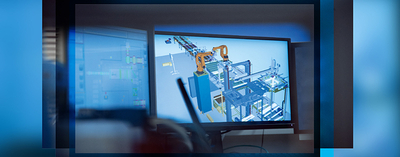
Digital twin: KHS lowers fault-related costs with virtual machine commissioning
In the future the digital twin will become a key component of industrial production. KHS already uses models to virtually map the machine and conveyor system commissioning process.
- Digital twin creates fully detailed virtual system image
- Virtual system commissioning to be increased
- Lead times reduced and fault-related costs lowered
Dortmund, May 5, 2020 – In the future the digital twin will become a key component of industrial production. KHS already uses models to virtually map the machine and conveyor system commissioning process.
With the help of smart, digital technologies KHS is networking and automating production processes step by step so that machines, products and complete lines can efficiently communicate and work with one another. “In particular what's known as the digital twin enables procedures to be transferred to a virtual environment by tracking and imaging all phases in a machine’s life cycle. All production processes and products can then be simulated virtually,” says Stefan Diesner, head of the Palletizing Product Center. Alternative, optimized production processes are displayed on the computer.
One of the major prerequisites for this is that engineering is consistent throughout the entire value chain in order to prevent what is known as data discontinuity at the interfaces between the various engineering disciplines, namely mechanical components, electrical equipment and software. Unlike the way a lot of work is done today, projects are not processed sequentially, i.e. separately and consecutively. Instead, in an ideal scenario all departments work in parallel across their respective disciplines on the implementation of a project and share a common data model – the basis for the digital twin that depicts every last detail of a system virtually and permits precise simulation.
The shared data challenge
For an engineering company like KHS, which not only manufactures a huge number of different machines but whose research and development departments also have a colossal geographical spread, this is a major challenge. The KHS engineers at the Palletizing Product Center in Worms have been working on the virtual depiction and simulation of machines and system parts for 13 years now. Simulation or virtual commissioning especially lend themselves to use with logistics systems such as palletizers or conveyors.
“Our aim is to continue to shorten lead times and lower fault-related costs by expanding our virtual commissioning setup,” explains Diesner. In order to estimate just how high these savings can be, it helps to take a look at the rule of ten. This states that the cost of fault correction increases by a factor of ten the later in the process an error is discovered. If a fault is only found and eliminated during factory commissioning, for example, the financial burden is ten times higher than if the correction had already been made to the software engineering during virtual commissioning.
Reduced time and effort
A further objective of the current project is to reduce the amount of time and effort required for virtual commissioning. One basic condition here is that the data is consistent. “With virtual commissioning we have control over data consistency,” Diesner explains. “All data is generated and stored at our production site, albeit still in a number of different systems. Further steps must be taken here before efficient and bidirectional access to this data is provided by a virtual engineering tool that includes simulation. Once this has been done, we can configure the system according to customer specifications or quickly and efficiently commission adapted machine designs on screen.”
In the meantime Worms is looking ahead: virtual commissioning is the first step towards digitalized systems for the beverage industry and the real digital twin. This will be able to do much more in the future, To this end, the digital twin has to be plied with more information, however, such as data on conversions for KHS customers or operational data from production – a challenging undertaking indeed.
About the KHS Group
The KHS Group is one of the leading manufacturers of filling and packaging systems for the beverage and liquid food industries. The KHS Group includes the following companies: KHS GmbH, KHS Corpoplast GmbH and numerous subsidiaries outside Germany, located in Ahmedabad (India), Sarasota and Waukesha (USA), Zinacantepec (Mexico), São Paulo (Brazil) and Suzhou (China).
KHS manufactures modern filling and packaging systems for the high-capacity range at its headquarters in Dortmund, Germany, and at its factories in Bad Kreuznach, Kleve, Worms and Hamburg, where the group's PET expertise is pooled. The KHS Group is a wholly owned subsidiary of the SDAX-listed Salzgitter AG corporation.
In 2018 the KHS Group and its 5,081 employees achieved a turnover of around €1.161 billion.
Digital twin
With the digital twin the mechanical components, electrical equipment and software programming must be able to access the exact same data.
Download image (JPG, 148 KB)Interface
When all data is provided through a shared interface, machines can be quickly and efficiently commissioned on screen.
Download image (JPG, 261 KB)Stefan Diesner
“In increasing virtual commissioning we want to continue to shorten lead times and lower fault-related costs,” says Stefan Diesner, head of the Palletizing Product Center.
Download image (JPG, 172 KB)


